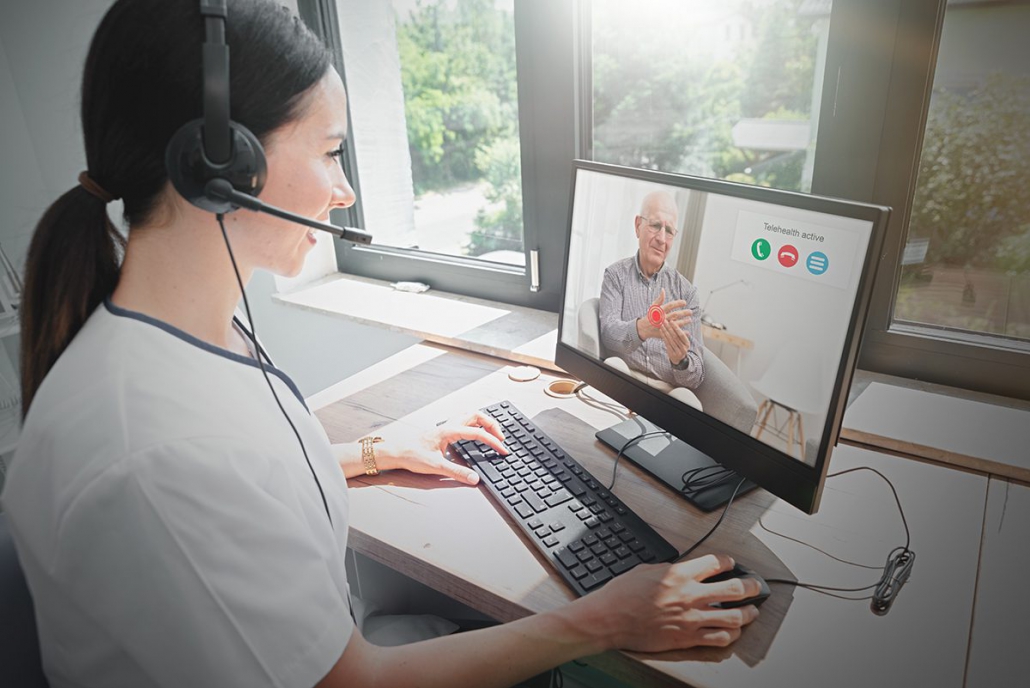
Telehealth: Does COVID-19 Spur a New Normal for Patient-Doctor Interactions?
by John Thomas & Wayne Lashua
WHAT IS TELEHEALTH?
Telehealth connects patients to vital health care services through technology, such as videoconferencing, remote monitoring, electronic consults, and wireless communications. By increasing access to medical professionals (e.g., physicians and specialists), telehealth helps patients receive the right care at the right place and the right time.
Nearly 76% of hospitals in the United States can connect with patients and receive payment for telehealth services, yet the widespread adoption of telehealth by healthcare professionals and patients has lagged. To establish telehealth as a core component of managing the health of the population, certain barriers, such as the limited coverage and payment by Medicare, would need to be overcome. Limited access to adequate broadband services, which can hamper the accessibility of telehealth to some patients and rural facilities, is another example.1
As coronavirus disease 2019 (COVID-19) challenges the capacity of our healthcare system, telehealth is allowing healthcare providers to continue responding appropriately to patients while maintaining social distancing. This virtual technology is helping reduce the risk of spreading SARS-CoV-2 (the novel coronavirus that causes COVID-19), as it provides an alternative to in-person visits and non-emergent appointments.
DOES TELEHEALTH HAVE STAYING POWER?
With the current COVID-19 pandemic, government agencies and health insurers are quickly revising guidelines and reducing barriers for telehealth utilization and reimbursement. This allows providers an opportunity to test telehealth capabilities and solutions.
Some providers believe these new guidelines may only last as long as the current emergency and suggest that telehealth will wane if the momentum isn’t actively maintained.2
Yet, early data suggests a positive future for the continued growth of telehealth. Some physicians report high patient satisfaction with telehealth, particularly video chats, and these physicians also report their own high satisfaction. Based on physician reports, patients are relieved to connect with and “see” their physicians, providing patients with a considerable amount of reassurance.
But does the move to increase telehealth as a key component of patient care have staying power? At this point, it is unclear. While the healthcare community may be interested in – and will certainly have the ability to continue – providing telehealth services once the pandemic subsides, three key growth determinants can be identified:
- Consumer familiarity
- Consumer evaluations of the experience
- Consumer perception of the security/privacy of their data
THE IMPACT OF COVID-19 ON TELEHEALTH ADOPTION AND GROWTH
Late last year, before COVID-19, we conducted a research study that explored consumer use of various digital healthcare tools, including telehealth. Our study found that:
- Telehealth was used by just 13% of all consumers
- 31% of telehealth users felt that using these services was very safe and secure from a data security perspective, an ongoing critical need in Healthcare. By comparison, 18% of telehealth non-users felt this way.
In response to the emergence of COVID-19 across America, we began to track critical issues regarding telehealth.

FAST FORWARD TO FEBRUARY 2020…
Burke’s February 2020 Telehealth A&U study revealed that there was still very low utilization (12%) of telehealth and the willingness to use (33% T3B) it was also low overall. The most frequently mentioned barriers to the use of telehealth were: expectation of lower quality care (17%), uncertainty regarding insurance coverage and reimbursement (14%), and privacy/security risks (13%).

NOW IN MARCH 2020…
Burke’s March 2020 Telehealth A&U Study revealed that utilization was still low but rising slightly (15%) and the willingness to use (48% T3B) grew rapidly overall.

WHAT DOES THIS MEAN?
Despite being a top barrier for some, most consumers are not critically concerned about their data security when using digital health tools, including Telehealth.
- Most believe that specific processes are in place to safeguard their data, and as such, data security is not a significant barrier to more widespread use of telehealth from the patient’s perspective.
- Of course, platforms and systems need to perform as designed and be diligently maintained to guard against high-profile breaches.
While utilization is still low, willingness to use telehealth is increasing dramatically (up 15% in just one month from February to March).
- Consumers who try telehealth are generally finding that it is an easy and convenient way to communicate with their provider (albeit with some technical glitches to work out on a case-by-case basis). The relative strength in willingness of users compared to non-users points to a more positive experience than expected.
Given these two factors, a swift increase in the use of telehealth is likely. The use of telehealth will continue to reach a much broader set of consumers willing and ready to leverage it as a core way to communicate with their provider – similar to the increased use of patient portals and email with one’s provider seen in recent years. In this time of uncertainty, telehealth provides comfort in its ability to keep patients connected with their providers. We believe it is poised for swift, sustainable growth, long after COVID-19 has been eradicated.

As Senior Vice President and Managing Director of Burke Healthcare, John leads a team of dedicated Healthcare researchers and consultants with specific expertise in patient experience, pharmaceuticals, medical devices and diagnostics, health insurance, distribution and health information technology.

As Vice President and Senior Account Executive, Wayne leverages strengths in divergent and convergent thinking to help teams make superior decisions. Wayne has over 20 years of experience working on significant healthcare related problems in brand management, market research, sales and leadership roles.
References:
- https://www.aha.org/factsheet/telehealth
- https://mhealthintelligence.com/news/what-will-happen-with-telehealth-when-the-emergency-is-over
As always, you can follow Burke, Inc. on our LinkedIn, Twitter, Facebook and Instagram pages.
Source: Feature Image – ©Proxima Studio – stock.adobe.com








